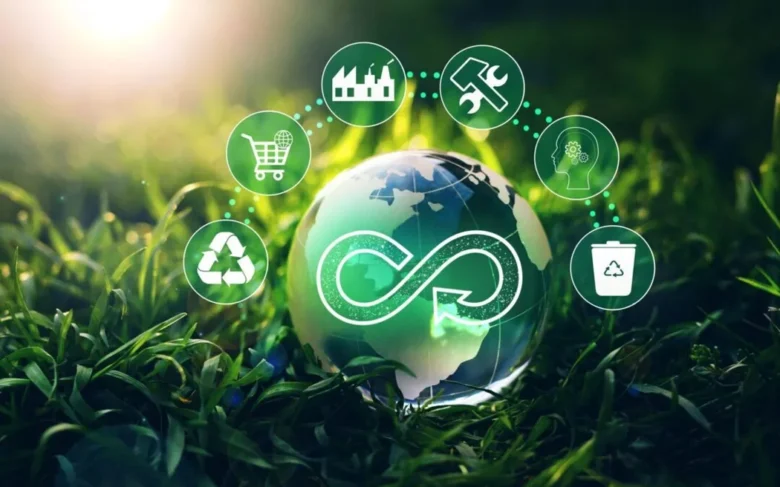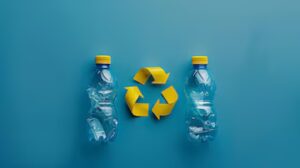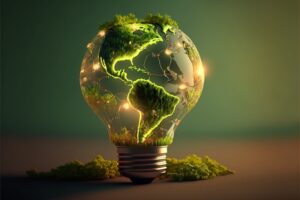The concept of the circular economy is rapidly becoming an important part of sustainable development. It offers a powerful alternative to the traditional “take, make, throw away” production and consumption model. The primary objective of the circular economy is to optimize resource utilization, minimize waste, and foster innovative ideas to enhance the sustainability of the system. Eco-innovation is a driving force that supports this mindset and opens up new ways for businesses to grow while protecting the environment. This article explores how eco-innovation is driving the circular economy and analyzes its role in different sectors, success stories, and potential challenges and opportunities for the future.
Understanding the Circular Economy:
The circular economy is a way to transform business operations and make them more sustainable. The circular economy focuses on regenerating resources, extending the life of materials, and creating products that can be reused and recycled, rather than using resources to create short-lived products that end up in landfills. The goal is to make a closed-loop system that reuses waste. It changes the way we perceive value creation by putting more emphasis on resilience, sustainability, and long-term positive environmental impact.
The circular economy disrupts the established order, stimulates innovative ideas, considers the life cycle of products during production, and rethinks global supply chains. The circular economy offers benefits in many sectors, including manufacturing, retail, energy, and agriculture. Eco-innovation is a key factor in making this concept scalable and practical in today’s industry.
How Eco-Innovation Advances the Circular Economy:
Eco-innovation refers to the creation and application of ideas, products, or processes that contribute to protecting the environment, improving resource efficiency, and supporting sustainable development. Eco-innovation fits perfectly into the circular economy because it brings about massive change by exploring new ways of designing, producing, using, and recycling things.
Eco-innovation provides the new technologies and innovative systems needed to make the circular economy work effectively. For example, advances in materials science have led to the invention of biodegradable materials and improved recycling methods. New developments in artificial intelligence and data analytics help optimize resource use and predict product lifespans, reducing waste and increasing usability. Ultimately, eco-innovation transforms vague circular goals into practical and scalable solutions that benefit businesses and consumers.
Eco-Innovation in Product Manufacturing:
It is often said that product design is the first step toward a circular economy, because choices made during the design phase can have a significant impact on the entire life cycle of a product. Eco-innovation leads manufacturers to adopt sustainable design concepts that prioritize durability, modularity, and recyclability.
For example, consumers of modular phones can replace parts without throwing away the entire phone. Brands are also creating eco-friendly products with recyclable and biodegradable materials to close the loop between material sourcing and disposal. Advanced manufacturing technologies, such as 3D printing, make it easier to produce products without wasting materials and tailor them precisely to your needs. Eco-innovation supports every step of the design and production process, enabling circular systems.
Eco-Innovation for Waste Reduction and Recycling:
The circular economy can only work if people can reduce waste and recycle it properly. Eco-innovation is changing the landscape in this area by developing technologies and systems that convert waste into useful resources. For example, chemical recycling methods can break down plastic waste into its basic components to produce high-quality recycled materials.
Today, digital platforms powered by artificial intelligence connect businesses with industries that might use their byproducts, encouraging collaboration and reducing waste. On the other hand, waste management projects transform food waste into biofuel or compost, a zero-waste strategy. Eco-innovation ensures that even the most robust materials are reused in production, eliminating waste.
Problems and Opportunities:
While the circular economy holds immense potential, it also presents numerous challenges that require resolution. First, companies that want to implement environmentally friendly methods usually have to make a large initial investment to switch from linear systems to circular systems. In addition, public awareness and government support for circular projects vary worldwide, making it harder for less developed regions to implement them.
But these problems also bring new opportunities. More and more governments and private investors are investing in eco-innovation research and development. Consumers are also genuinely interested in environmentally friendly products, which provide companies more reasons to embrace circular concepts. Collaboration with companies, nonprofit organizations, and governments can further accelerate this transformation.
The Future of the Circular Economy and Eco-Innovation:
The development of eco-innovation is closely linked to the future of the circular economy. With the advancement of artificial intelligence, material science, and renewable energy, we can expect more and more opportunities for circular models. To ensure that products are as sustainable as possible, companies can start using digital twins and IoT monitoring technologies. At the same time, advances in bioplastics and carbon capture technology can significantly reduce the environmental impact of manufacturing processes.
Furthermore, cross-sector collaboration will transform the value chain so that ecosystems develop together rather than against each other. The rise of sustainable, socially responsible companies and startups suggests that eco-innovation will continue to be a key component of global change.
Conclusion:
Eco-innovation drives the circular economy by pushing the boundaries of design, manufacturing, and waste management to create a better future. Businesses across all sectors can identify ways to protect the planet, improve operations, and satisfy environmentally conscious customers through eco-innovation. Now is a good time to invest in eco-innovation. We can create a world where resources no longer flow in one direction but form a never-ending cycle of value and regeneration.
FAQs:
1. What does “eco-innovation” mean?
Eco-innovation is the process of creating new concepts, products, or technologies that are better for the environment and more efficient.
2. Can the circular economy function well without eco-innovation?
Eco-innovation is an important part of the circular economy because it can develop systems, processes, and technologies that help reduce waste and use resources more efficiently.
3. How can businesses benefit from a circular economy?
Adopting a circular economy can save money, reduce waste, improve brand reputation, and open up new ways to make a profit through innovative business models.
4. Which sectors benefit most from eco-innovation?
Eco-innovation has helped industries such as manufacturing, agriculture, retail, construction, and energy by maximizing the use of resources and reducing the impact on the environment.
5. What role does technology play in advancing the development of the circular economy?
Artificial intelligence, machine learning, and advanced recycling methods are all key technologies that help the circular economy to maximize resources, reduce waste, and be more sustainable.




